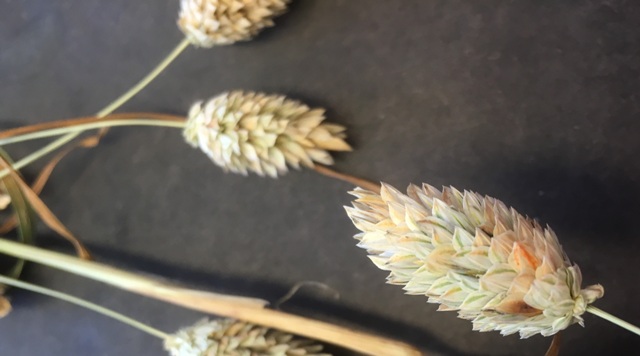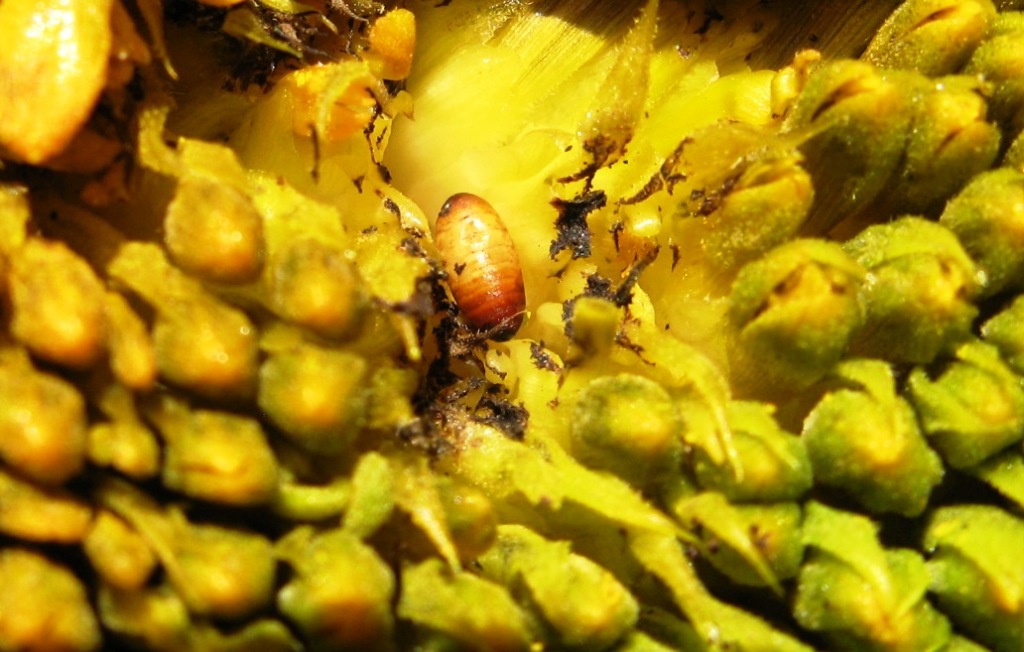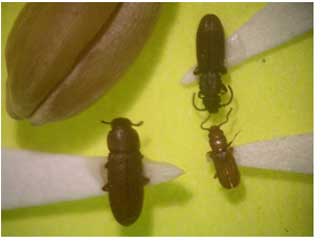Manitoba Insect & Disease Update
Issue 13: August 10, 2016
Summary
Insects: Insects of highest importance to scout for currently are Lygus bugs in canola and sunflowers, and banded sunflower moths in sunflowers. Only trace levels of soybean aphids have been found so far. There have still been no reports of high levels of larvae of bertha armyworms in Manitoba.
Plant Pathogens: Various diseases continue to be reported in field crops.
Disease Update
Canary grass: Fusarium head blight and root rot due to Fusarium spp was found in canary grass.

Figure 1. Fusarium head blight in canary grass
Peas: Pink seed of pea caused due to a bacterial pathogen, Erwinia rhapontici was reported in a field at low level. E. rhapontici is a bacterial pathogen that can cause yield and quality loss in peas. Fungicide application is not effective against this disease.
Corn: Goss’s wilt is being found in fields with multiple years of corn and less tolerant hybrids.
For more information, http://www.gov.mb.ca/agriculture/crops/plant-diseases/goss-wilt.html
For more information, http://www.gov.mb.ca/agriculture/crops/plant-diseases/goss-wilt.html
Insects on Sunflower Heads
Lygus bugs and banded sunflower moth are present in sunflowers and in some fields presence of sunflower seed maggots has been noted. There have been no reports of high levels of sunflower seed weevils in Manitoba.
When does it become too late to manage Lygus bugs in sunflowers? In research trials in North Dakota, damage to sunflower heads by Lygus bugs was approximately twice as severe when feeding occurred at late bud and early bloom compared to stages when heads had completed flowering. At these earlier stages, the feeding will injure the kernels and the destruction of the cells will result in the characteristic depressions and browning of the kernel. If adult densities reach the economic threshold, lygus bug management should be initiated prior to or at the beginning of the bloom stage.
When flowering has finished (by R6) the seeds are probably too mature to sustain damage any longer.
Also consider that in flowering sunflowers there will be pollinators, which are also helping improve yield of the sunflowers, as well as providing a livelihood for beekeepers. The only insecticides registered for Lygus bugs in sunflowers are Matador and Voliam Xpress, which can not be applied to flowering crops when bees are visiting the treated area. Both labels also state "spray deposits should be dry before bees commence foraging in treated crop". So if treatment is necessary for Lygus bugs in sunflowers, spraying as late in the day as practical is preferred.
Pupal cases on sunflower heads: This time of year you may find small brown pupal cases on the heads of some sunflower plants (see figure 2 below). These are the pupae of an insect called the sunflower seed maggot (Neotephritis finalis). Larvae feed on the florets and the first generation pupates in the head. They are generally considered to be not economical to sunflower seed production, however studies on the economics of this insect are being conducted in North Dakota.

Figure 2. Pupa of sunflower seed maggot
Insects in Stored Grain
Preventing stored grain insects: A reminder before moving and storing new grain to clean old grain out of bins, augers, combines, truck beds, and other areas where grain or grain debris may be. Infestations of stored grain insects such as rusty grain beetles usually do not get started by harvesting the insects along with the grain. They are often the result of insects already being present in bins or equipment used to move grain, or insects being able to get into the stored grain through openings in bins or storage structures. Figure 3 (below) is a picture of a sawtoothed grain beetle (top right), red flour beetle (bottom left), and rusty grain beetle (bottom right) with a grain of wheat (top left) to give perspective on size.

Figure 3. Some beetles that may occur in stored grain.
Some insects in stored grain, such as the rusty grain beetle, will feed primarily on the grain, while others, such as foreign grain beetle, may be feeding primarily on molds growing on grain that is too moist. So it is good to know the species you are dealing with as management options may differ. Additional information on identifying and managing insects on stored grain can be found at: http://www.gov.mb.ca/agriculture/crops/insects/prevention-and-management-of-insects-and-mites-in-farm-stored-grain.html
For long-term storage of grain, lowering the grain temperature below 15C as soon as possible after the grain is placed in storage can help minimize the risk of stored grain insects. Below 15C potential insect pests of stored grain stop laying eggs and development stops. Grain that is not aerated or moved after harvest can often remain warm enough for insects to survive the winter.
For long-term storage of grain, lowering the grain temperature below 15C as soon as possible after the grain is placed in storage can help minimize the risk of stored grain insects. Below 15C potential insect pests of stored grain stop laying eggs and development stops. Grain that is not aerated or moved after harvest can often remain warm enough for insects to survive the winter.
Insect Monitoring Programs
Grasshopper Survey: A reminder for those participating in the grasshopper survey, that counts are done during August, when the majority of grasshoppers are in the adult stage. Even if grasshopper levels are low in your area, this is valuable data for the survey. So don't not do counts in a region because grasshopper levels are low. The purpose of the survey is to map what average grasshopper levels are like in a region, so waiting until a high level is encountered to do an assessment would bias the data.
Agronomists and farmers who would also be interested in estimating grasshopper numbers in the fields they are in and have this information included in the survey are encouraged to see the survey protocol for more details of the survey and where to send data. Estimates of grasshopper levels can be collected during regular farm visits.
"Estimates" of grasshopper populations is stressed as it will not be possible to accurately count grasshoppers along a field edge or ditch area as they will be moving around as you get near the area of the count. But estimate of what is present gives us some idea of the relative numbers that are present in different areas.
Data from the survey, along with weather data during the egg laying period of the grasshoppers, is used to produce a forecast for 2017.
The protocol and data sheet for the grasshopper survey is at: http://www.gov.mb.ca/agriculture/crops/insects/mb-grasshopper-survey.html
"Estimates" of grasshopper populations is stressed as it will not be possible to accurately count grasshoppers along a field edge or ditch area as they will be moving around as you get near the area of the count. But estimate of what is present gives us some idea of the relative numbers that are present in different areas.
Data from the survey, along with weather data during the egg laying period of the grasshoppers, is used to produce a forecast for 2017.
The protocol and data sheet for the grasshopper survey is at: http://www.gov.mb.ca/agriculture/crops/insects/mb-grasshopper-survey.html
Compiled by:
John Gavloski, Entomologist Pratisara Bajracharya, Field Crop Pathologist
Manitoba Agriculture Manitoba Agriculture
Phone: (204) 745-5668 Phone: (204) 750-4248
To report observations on insects or plant pathogens that may be of interest or importance to farmers and agronomists in Manitoba, please send messages to the above contacts.
To be placed on an E-mail list so you will be notified immediately when new Manitoba Insect and Disease Updates are posted, please contact John Gavloski .

